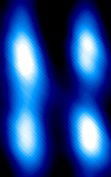Defects in Solid Materials

The concept of emergent behavior—where small perturbations at the atomic scale induce significant changes in the collective properties of matter—lies at the heart of understanding the relationship between individual and collective phenomena in condensed matter systems.
In crystalline solids, the physical properties and functionalities are primarily governed by the periodic arrangement of atoms. However, imperfections such as point defects can break this periodicity, often giving rise to dramatic modifications in electronic, chemical, and mechanical behavior. Metal oxides serve as prototypical materials in this context, where oxygen vacancies, adsorbates, and interstitial ions critically influence their macroscopic properties. Despite extensive research, the underlying mechanisms by which these defects affect material performance remain incompletely understood.
Scanning probe microscopy (SPM) offers a powerful approach for directly observing these atomic-scale defects and characterizing their local properties with high spatial resolution. Our work has focused on titanium dioxide, where we have investigated defect-induced electronic states, interactions with supported metal clusters, and atomic-scale defect manipulation and reactivity. By extending these analyses to in situ or operando conditions, we aim to elucidate the dynamic mechanisms of defect-mediated processes and uncover the real-space origins of complex, correlated phenomena.
小さな摂動を加えることで全体に大きな変化を与え、興味深い新しい現象を生み出すことは、個と多の概念形成において重要な役割を果たす。
原子の集団である固体が持つ機能や物性は原子の配列によって定められるが、その配列を乱す欠陥が機能や物性に大きな影響を与えることがある。金属酸化物はその代表的な材料であり、酸素欠損、吸着原子、格子間元素などの欠陥によって、その機能や物性が大きく変化する。しかし、その機構については、不明な点が多い。
走査プローブ顕微鏡などの手法を用いると、これらの欠陥を原子レベルで直接観察し、その物性を解析することが出来る。これまで、二酸化チタン表面の欠陥が生み出す電子状態、金属クラスターとの相互作用、欠陥の操作反応、反応機構などを解析してきた。反応条件下での解析によって、より複雑であるが、実空間との関連が強い現象の機構を明らかにする。
Representative papers
触媒 62, 15 (2020).
ACS Nano 9, 6837 (2015).
Chem. Rec. 14, 923-934 (2014).
J. Chem. Phys. 130, 124502 (2009).